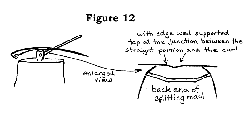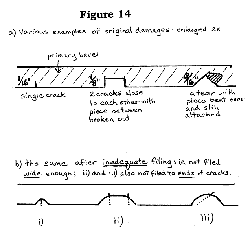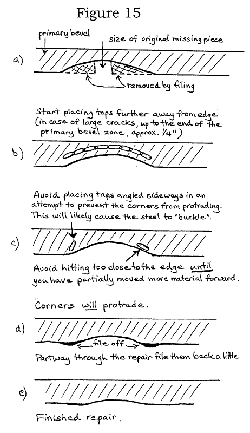Repairing a damaged edge
(Adapted from buy isotretinoin online fast delivery The Scythe Must Dance by Peter Vido, published in 2001 as an addendum to buy modafinil adelaide The Scythe Book by David Tresemer.)
Click each image for a larger view.
Scythe blades used by inexperienced mowers (and frequently even by veterans!) will periodically require some edge repair. I would like to emphasize that damages should be dealt with in turn as they occur rather than allowed to accumulate until the blade is peened. The shaping of the entire edge and the repairing of a small portion of it are distinct tasks. If the edge is damaged about the time the whole blade is also due to be peened, I would complete the repair first and only then proceed with the actual peening.
For the purpose of repairs, hammers and portable anvil setups were traditionally taken to the field, often shared by a group of mowers. I have also, on occasion, used two rocks to straighten out a simple “dent”, a piece of bent but unbroken edge. This would be better than ignoring such damage; one or two rough spots, even if a beginner does not notice the extra wear on the body, will wear the whetstone faster.
For repair work alone, the hammer and anvil are handier and more precise than the peening jig, simply because the very localized area can be viewed unobstructed by the jig’s cap.
If a dent is not very pronounced and especially if bent downward, the jig will work well. If it is curled down considerably, begin the repair by tapping it back into place with only the hammer and then finish on the jig, using the second cap. More frequently, though, dents are bent upward and best repaired “upside down”. For this the hammer is preferable. In the absence of a bona fide peening anvil, the poll of an ax or splitting maul driven into a block of wood is a decent substitute.
 |
The jig will work well in cases where a longer section of the edge is seriously blunted (after being run into a wire fence, for instance). Often it will be somewhat “ragged” as well; file it smooth before peening.
The more troublesome damages are perpendicular cracks and variously-shaped pieces torn from the edge. The latter are often predisposed by cracks, but can also happen independently if the blade hits a sharp edged object (e.g. a piece of scrap metal forgotten in the grass) or the corner of a partly buried rock. It will likely be a tear if the edge was thin; with a thicker, more durable edge, there may be a crescent-shaped piece broken out.
The cracks themselves can be caused suddenly, for example when the blade strikes the dry stump of a previously-cut sapling or burdock. The edge should dent if shaped appropriately for such an encounter; if too thin, it may “buckle” or twist before severing the stem. The extent of the damage will be relative to:
- The toughness of the plant material,
- the shape of the primary bevel,
- the skill of the smith who crafted the blade,
- the quality of steel it was made of and, of course,
- The sense of the mower who is guiding the tool.
Admittedly, this is a large dose of relativity, difficult to consider all at once; a beginner could not be expected to take all the above points into consideration. In due time we all become wiser. Still, sooner or later most people using the scythe often or under diverse conditions will be confronted with the type of damage described below.
The blade may end up with several cracks (usually in a group) from just one swing; the following swing, particularly if directed at a similar target, will compound the damage. It may lengthen the cracks, create more of them, remove small pieces of steel between two cracks, and/or bend part of the edge over. (See Figure 14 a). An edge so thoroughly “schrupped up” will no longer perform as it did; hopefully before another swing the mower will notice what happened and stop to repair the damage.
The above may sound dramatic but is no cause for real alarm. A short section of such an edge will hardly present more difficulty than two or three individual large cracks. But before the mending process begins, let me add that very likely a large portion of the perpendicular cracks are caused either directly or indirectly with the hammer. Overzealous or inaccurate hammering may stress the steel in one or more spots along the edge nearly to the point of breaking, until a perhaps minor challenge finishes it off.
The challenge may be more of the same kind of hammering at a later date. The mower might cut only young lawn grass in the meantime and not realize what is lurking on the horizon. The cracks may be too tiny at first to be noticed with the naked eye, and may not impair the blade’s performance seriously; peen the blade more and the cracks will grow longer and more troublesome. Corners of the edge next to them often bend out and start catching grass. At this point the user will take note, but may curse the blade that cracked “on its own”, being sure he did not cut into anything tough.
This is not a hypothetical story; it is an actual interpretation of some people’s “difficulty with the scythe”. Therefore keep in mind that even one session of “bad” peening could take the edge all the way from a state of soundness, through one of stress, to miniscule cracks and then possibly serious ones. It is very helpful to periodically check the edge under magnification. A 3x glass will already be revealing; 10x is much better. If cracks are detected, hammering in their vicinity should be done very carefully or avoided completely. No amount of peening, however skillful, will again reconnect the intermolecular bonds, i.e. re-join the two sides of the crack.
To be effectively repaired, cracks must be removed completely. A file is the most appropriate tool for the job; a half-worn-out 15cm/6″ chainsaw depth gauge file is my favourite, though any fine-cut flat one will do).
Before a thorough repair is considered, a compromise approach may be tried in some cases. A single perpendicular crack, even if quite large (6mm. long), can be left intact and watched closely. It may cause no trouble for a long time and gradually wear off in use. Whenever the blade is peened, avoid striking that area perhaps 4-6mm. on either side of the crack. Instead, shape that part of the edge with a synthetic whetstone stone only and keep it a little thicker than the rest.
The kind of diagonal crack left after tapping back the protruding and bent-over piece of a tear is a different story. After a portion of the edge was stressed this much (by the extreme bending), it will lose some of its “stiffness”. The corner may continue to bend out again in use and catch grass, eventually breaking off, and until then it will be a nuisance.
 |
I used to be more concerned with saving every bit of steel, and would not file off enough as in Figure 14-b. But in trying to shape the area so it becomes a useful edge again, I would sometimes actually lengthen the crack. This often happens as a result of hammering on or near a crack. For the edge to be restored well, the cracks must be filed off completely. This should not be attempted over too narrow an area, but gradually blended with the existing sound edge.
Figure 15 represents a thorough repair in progress. The taps should be gentle, overlapping and sometimes reach further up the primary bevel zone than is advisable for ordinary peening (in serious repairs, up to 6mm/1/4″.) There is no need to bring the edge back so it is perfectly even.
 |
To be continued…
Oct. 2006

